Peter the Great Trendsetter: National Change through Fashion
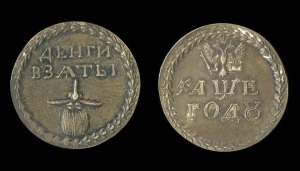
The monthly ArtSmart Roundtable brings together some of the best art-focused travel blogs to post on a common theme. This month we are discussing Fashion! Take a look at all the great stories at the bottom of the page.

A Monument to Peter the Great in Taganrog, Russia (Photo)
Peter the Great (1672 – 1725) is a legitimate candidate for the the Most Interesting Man in the World. Physically impressive at 6 foot 8 inches tall, he disregarded his royal status and sought out hands-on experience with the military, international trade, and sailing technology. Realizing this country needed an Atlantic shipping port, he planned and constructed St. Petersburg from absolutely nothing. Peter I’s reign was a revolutionary time for Russia; he brought the nation from medieval neglect to the Age of Enlightenment. Emblematic of the massive political and technological changes he made, Peter’s reforms included forcing Russians to completely update their wardrobe – which was not nearly as easy as it sounds.

Andrey Petrovich Ryabushkin – ”Tsar Mikhail Feodorovich at the session of the Boyar Duma” 1893, Tretyakov Gallery, Moscow. Though he lived from 1862-1904, Ryabushkin faithfully reproduced 17th century Russia in his genre painting. For example, Tsar Mikhail shown here reigned from 1613-1645. (Image)
Russia of the 17th century had changed little over the last 600 years. The Tsar was supported by a ruling class of nobles (or boyars) who gained their wealth largely at the expense of a massive, enslaved serf population. This feudal system worked in concert with the powerful Orthodox church headed by the Patriarch. Whether they were ready for them or not, Europe’s rapid advances in technology and trade finally brought outsiders to Russia in the 17th century. At the time of Peter’s birth in 1672, there was a community of merchants and ambassadors from Germany, the Netherlands and the British Isles in Moscow. Drawing the suspicion of local, these foreigners lived separately in their own neighborhood.
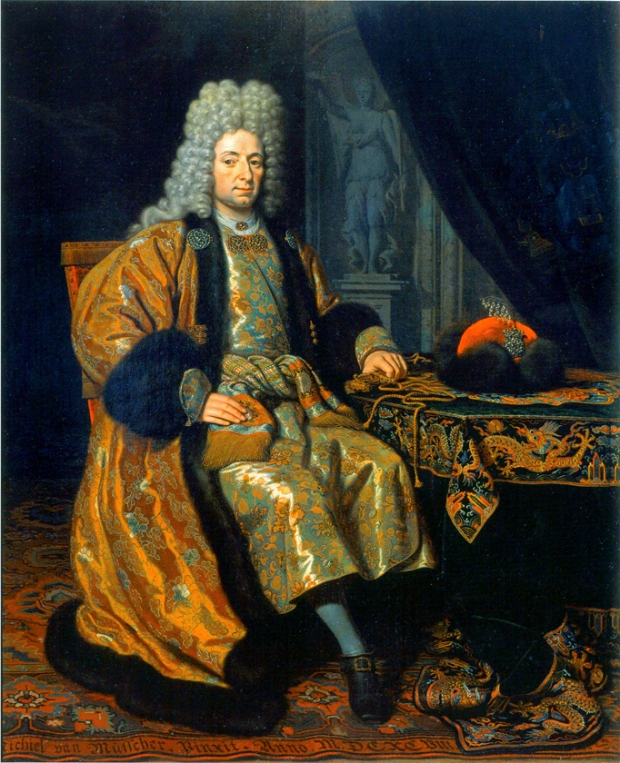
Swiss-born Franz Lefort came to Russia as a mercenary in the 1670’s. He eventually became one of Peter’s most trusted advisers. Here he is shown in a Russian costume (but with French wig and shoes) during Peter’s trip to the Netherlands. “Portrait of François Lefort” by Michiel van Musscher, 1698 (Image)
Peter’s mother Natalya, the future second wife of Tsar Alexis I, had been sent to Moscow by her family and was raised by a progressive, Western leaning boyar and his Scottish wife. As a result of her education, Natalya ensured that Peter was taught mathematics, languages, history, and military strategy by imported European teachers. Peter spent most of his youth pursing his interest in warfare technology, sailing, and shipbuilding, rather than actively co-ruling with his half-brother.
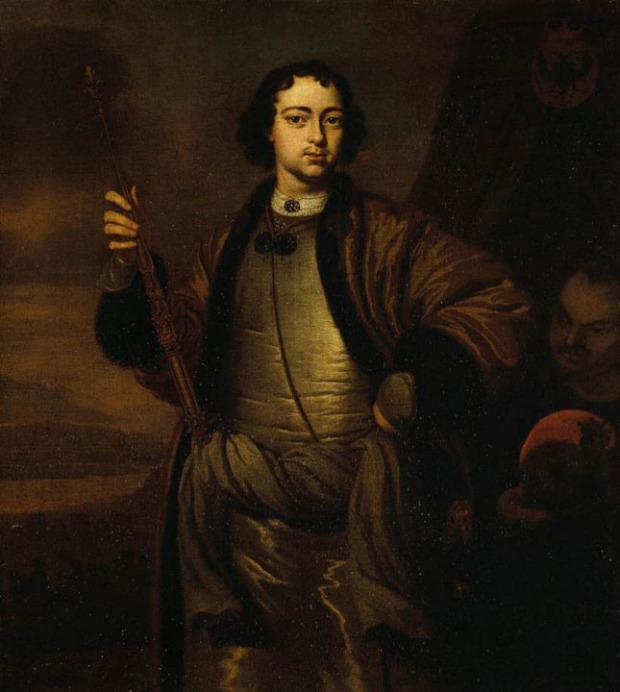
Pieter van der Werff “Portrait of Peter the Great”, 1690s, The Hermitage, St. Petersburg. Clearly painted before his study abroad, a young Peter is shown in Russian clothing. (Image)
Shortly after becoming sole Tsar in 1696, Peter took a surprising 18 month trip to the Netherlands and England. He sought out and absorbed everything he could about Enlightenment science and technology. Protected by a pseudonym, he even worked building ships for the Dutch East India company. Forgoing the lavish royal accommodations prepared for him, Peter chose to live in a simple wooden house which can be visited today in Zaandam.

Peter playing cards with perhaps some friend from the shipyard. Unknown Dutch Artist, “Peter the Great in Holland”, 1690s, Hermitage Museum, St. Petersburg. (Image)
After Peter’s impressive “internship” abroad, he brought back new tools, technologies, and ideas to rapidly bring Russia up to speed with the rest of the Western world. More astutely though, Peter realized that Russia needed more than just technology, it needed a complete paradigm shift in its political and social structure if this modernization was going to be successful.

Satirical print in which a barber is going after the beard of an “Old Believer” during Peter’s reign. (Image)
The day Peter returned to Moscow in September 1698, a dozen or so top boyars, who had been running the country in Peter’s absence, came to meet him. He thanked them, they talked, and then he immediately made them shave off their long beards. The men stood in shock as each one was shaved. Later that winter, Peter surprised guests at a banquet by announcing that all men had to be shaved right then and there. Peter shocked guests at another event but cutting off the billowing sleeves of several boyars’ robes, joking that now they wouldn’t be dragging their clothes through their food.
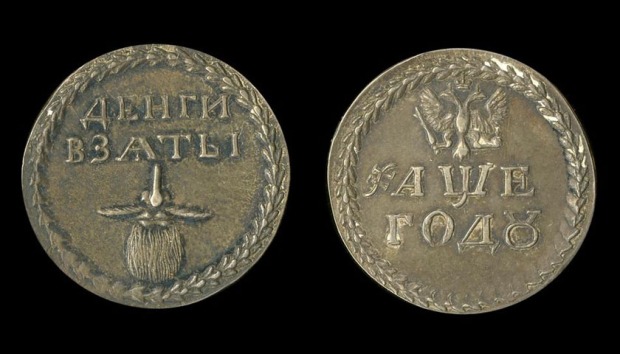
Proof that you’d paid the Russian beard tax. (British Museum)
In January of 1700, Peter decreed that all boyars, government officials, and landowners could no longer wear Russian robes and had to wear Hungarian style caftans. This was followed up by another decree in 1701 stating that men had to wear French or German styled clothing (i.e. waistcoat, breeches, gaiters, boots & hat) and that women had to wear petticoats, skirts, and bonnets. If you were in traditional clothes (except for peasants), then you had to pay a tax to enter Moscow. Men who wanted to keep their beards had to pay a significant tax and had to wear a metal proving they’d paid or else roving government barbers could shave them on the street. Peter’s fashion reforms were swift, extreme, and met with a great deal of resistance.

Russian boyars in the 16th–17th centuries (Image)
Russian clothing at the time consisted of long robes, coats, and boots. There was almost an Oriental look to this fashion that hearkened to the steppes of Asia and Russia’s distant past. Because these items restricted movement, Peter though this fashion was entirely impractical. Beards were also totally out of fashion in Europe and were equated with ignorance; Peter saw that Russians with their silly long beards were the butt of jokes in the Netherlands. However, for Orthodox Russian, the beard was a symbol of piety and religious commitment. Loosing their beards was a horror that many Russian men had trouble accepting. They found back and were very willing to pay Peter’s beard taxes. Unsurprisingly, non-religious Peter didn’t care and continued to force Western style clothing and manners on the nobles eventually even eliminating the beard tax option for everyone except the ordained.
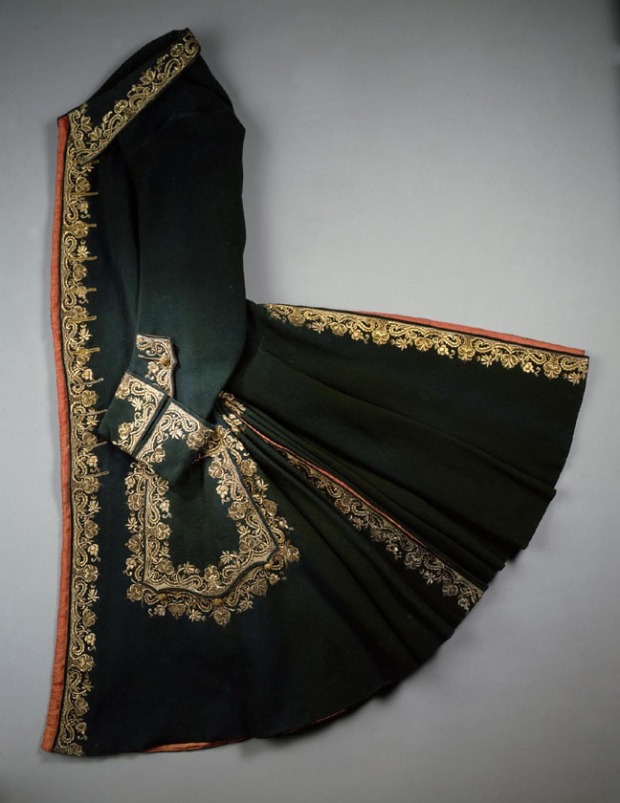
A coat from the Official Dress Collection of Peter the Great, 1720s, Hermitage Museum, St. Petersburg, Russia (Image)
Ultimately the battle wasn’t just about clothing. Fashion was a surrogate for the political and social structure of corrupt nobles and religious leaders. Peter gave government positions to men who earned them through intelligence and merit, rather than to wealthy or important boyar families. Clothing was an easy way to tell who was willing to evaluate new ideas. Peter also fought against and disbanded the rebellious Streltsy, a order of Russian knights determined to maintain the feudal structure. He also made the massively wealthy Orthodox Church pay for schools, hospitals, and supplies for the serfs. Citing their Christian mission, he argued that the Church should be taking care of both the spiritual and physical well-being of their followers, rather than just profiting.
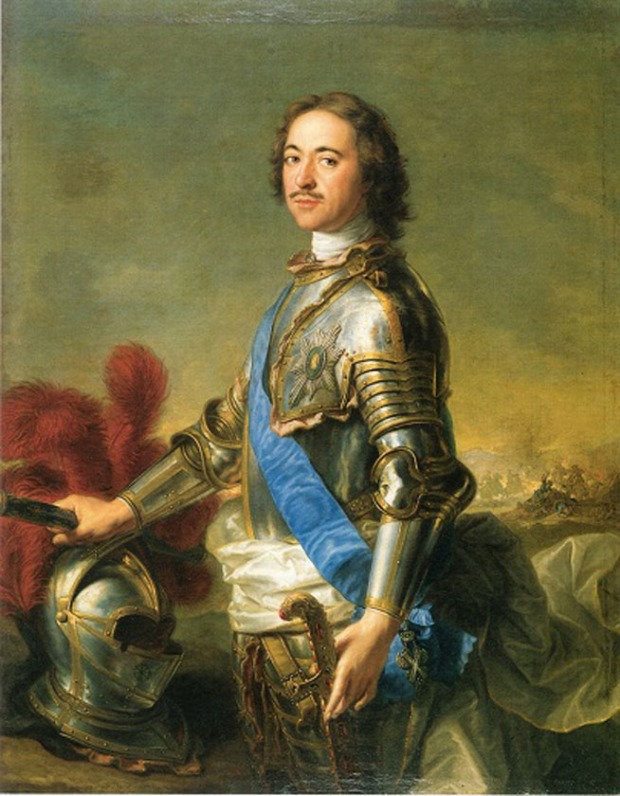
J.-M. Nattier , “Portrait of Peter the Great”, 1717 (Image)
Peter died at age 52. During his reign, Russia built a Navy from scratch, became proactively engaged in international trade, won major battles against Sweden, reformed its political system, and opened itself to Enlightenment science and technology. All of these sweeping changes can be attributed to one great man who brought his country from backward isolation to the modern world. Peter both figuratively and literally, as we’ve seen from his fashion mandates, changed the look of Russia.
If you’re interested in Peter I or Catherine II (both of which are known as “the Great”), I definitely recommend Robert Massie’s biographies of these leaders! Don’t let the length stop you, these are amazing books about two incredible people.
For the rest of the September ArtSmart Roundtable, check out:
- Lizzie of Wanderarti –Dismaland: The Fashionable Way to ‘Do’ An Art Show
- Murissa of Wanderful Traverler – The Fabulous Fashions of Milena Canonero
- Pal & Lydian of Art Weekenders –Fashion in The Netherlands – Exhibitions Fall/Winter 2015
- Alexandra of ArtTrav – The best and worst of Renaissance Fashion
- Jenna of This My Happiness – Why do Italians Always Look Good?





This is amazing, how did you learn all this?! I’m terribly ignorant and never knew ANY of it. I would suggest only one integration: adding Peter’s dates right up at the top (from the statue, being ignorant, I thought we were looking at the 19th century).
Question – what’s with the swaths of cloth around the waist?
LikeLike
How interesting that he literally went for the jugular and made them all shave their beards upon his return. How interesting these seemingly small changes (although not necessarily for the individual) were so instrumental. But then again when someone is used to their own style habits for whatever reasons – religious, political or just personal preference – small changes do make a big difference. Interesting to think how fashion plays a big role for people back then and today as well.
LikeLike
I’m with Alexandra…wow, you gave us a lot of information here! Impressive! And I love your last paragraph that sums up his influence. I admit that I knew very little about Peter the Great.
LikeLike
I second your nomination for Most Interesting Man in the World. There is a lot of information about Peter the Great in museums here in Riga and Tallinn – they even have his tall leather boots on display! It’s amazing how much influence one man can have on society.
LikeLike
How one person can have so much influence on society! It’s especially impressive given the time he lived in. Interesting to read as well where he got his influences from!
LikeLike
Facinating post, Christina. I saw an excellent exhibition about Peter the Great in Amsterdam a couple of years ago. They had some of his actual garments on display, including an exquisite dressing gown, quite diaphanous pale blue silk to my memory. He had great taste but an odd shape, very tall and very narrow chested/thin.
Another show ‘all about fashion’ is the Elizabeth Louise Vigee Le Brun exhibition currently at the National Gallery of Canada in Ottawa. Anyone who loves costume, fashion, women’s history and fabulous painting will love this show. Major, major works. There is a co-exhibition called the White Dress, so wrought with meaning was the chemise at the time. Meaning that changed after the Revolution.
Anyways, great theme, great post!
LikeLike